Survey Description
Small business lending conditions were stable in the second quarter of 2018. Respondents to the Federal Reserve’s Small Business Lending Survey (FR 2028D) indicated that outstanding small business loans and new originations in the second quarter increased slightly from the first quarter. While credit line usage remained relatively unchanged, interest rates on small business commercial and industrial (C&I) loans continued to rise amid reports of some tighter lending terms.
Chart 1: Small Business C&I Loan Balances Increase Slightly
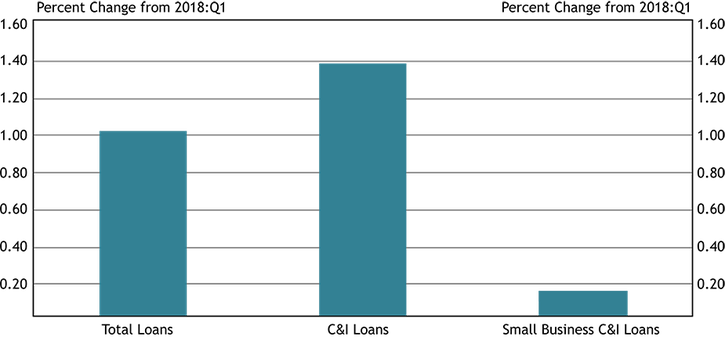
Sources: Call Report, schedule RC-C, items 4 and 12, and FR 2028D, items 4.b and 5.c.
Note: Items are calculated using a subset of respondents that completed the FR 2028D for both the first quarter and second quarter of 2018.
Total outstanding loans increased from the first quarter. Outstanding C&I loan balances grew for the second consecutive quarter. After a decline in first quarter, small business C&I loans in the second quarter showed a slight increase.
Chart 2: Small and Large Institutions Drive Growth in Outstanding Small Business C&I Loans
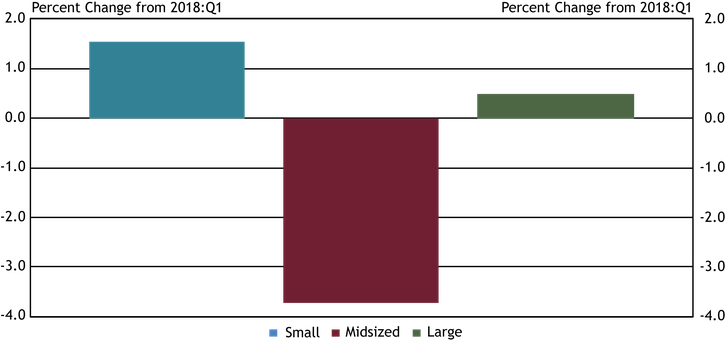
Source: FR 2028D, items 4.b and 5.c.
Note: Small banks have total assets of $1 billion or less, midsized banks have assets between $1 billion and $10 billion and large banks have assets greater than $10 billion.
Small and large institutions drove growth of outstanding small business C&I loans in the second quarter. Outstanding small business C&I loans at small and large banks grew 1.5 percent and 0.5 percent, respectively, offsetting a decline in outstanding small business C&I loans at midsized banks of 3.7 percent.
Chart 3: New Small Business C&I Originations Trend Upward
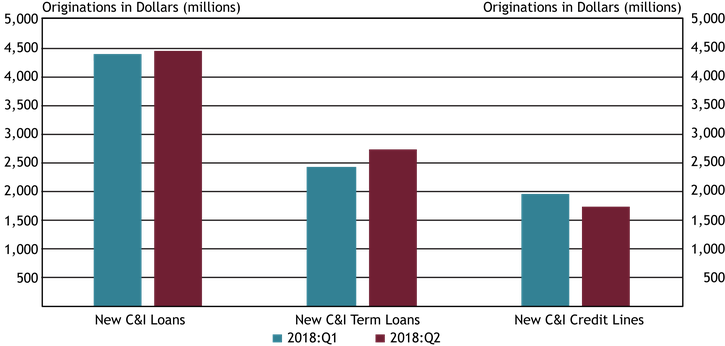
Source: FR 2028D, items 7.b and 10.c.
Note: Items are calculated using a subset of respondents that completed the FR 2028D for both the first quarter and second quarter of 2018.
The overall dollar volume of new small business C&I loans grew 1.4 percent from the first quarter. Originations of C&I term loans grew 12.0 percent but were offset by a decline in new C&I credit line originations of 11.8 percent. The overall increase in new C&I lending is consistent with the increase in outstanding small business C&I loans this quarter (Chart 1).
Chart 4: Credit Line Usage Remains Nearly Unchanged
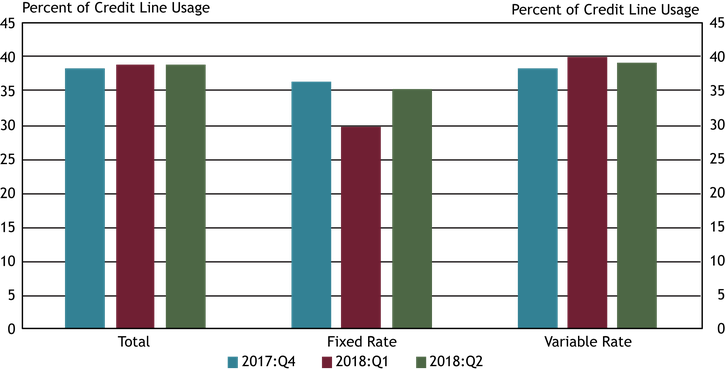
Source: FR 2028D, items 5.b and 5.c.
Note: Calculation uses a subsample of the data collected for sample consistency.
Similar to the first quarter, total credit line usage remained relatively stable, increasing only 0.1 percent. Fixed rate credit line usage rebounded in the second quarter, increasing 5.5 percent and nearly matching levels seen during the fourth quarter 2017. Variable rate credit line usage was largely unchanged, declining 0.6 percent from the first quarter and aligning closely with levels in the fourth quarter 2017.
Chart 5: Interest Rates on New Small Business C&I Loans Rise
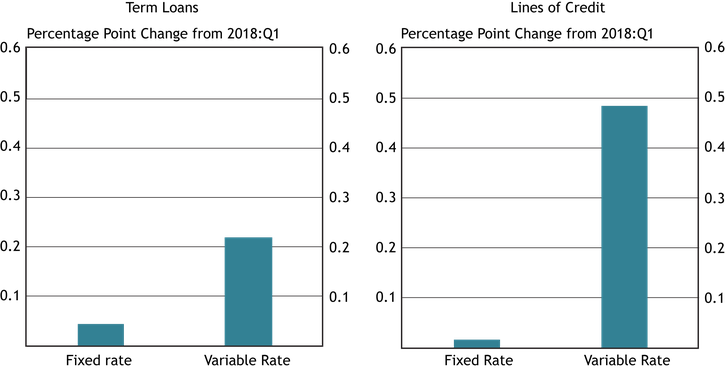
Source: FR 2028D, items 7.c and 10.d.
Note: Items are calculated using a subset of respondents that completed the FR 2028D for both the first quarter and second quarter of 2018.
Weighted average interest rates on new fixed rate term loans increased only 0.04 percentage points to 5.0 percent, while the rate on variable rate term loans increased 0.22 percentage points to 6.4 percent during the second quarter. Weighted average interest rates on new fixed rate lines of credit rose 0.02 percentage points to 5.5 percent, while the rate on variable rate lines of credit increased 0.48 percentage points to 5.6 percent.
Chart 6: New Small Business C&I Loan Rates Vary by Bank Size
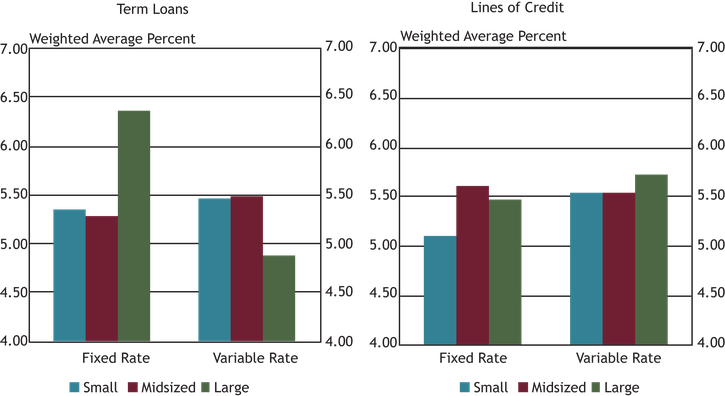
Source: FR 2028D, items 7.c and 10.d.
Note: Average interest rates are weighted by the dollar volume of new small business C&I loans. Small banks have total assets of $1 billion or less, midsized banks have total assets between $1 billion and $10 billion and large banks have total assets greater than $10 billion.
Second quarter weighted average interest rates varied across bank sizes and, similar to the first quarter, ranged from 4.9 percent to 6.4 percent. Small and midsized banks offered lower rates than large banks on fixed rate term loans and variable rate lines of credit. Small banks also charged the lowest rates on lines of credit with fixed rates. Large banks offered the lowest rates on term loans with variable rates.
Chart 7: Credit Line Usage Relatively Stable Across All Bank Sizes
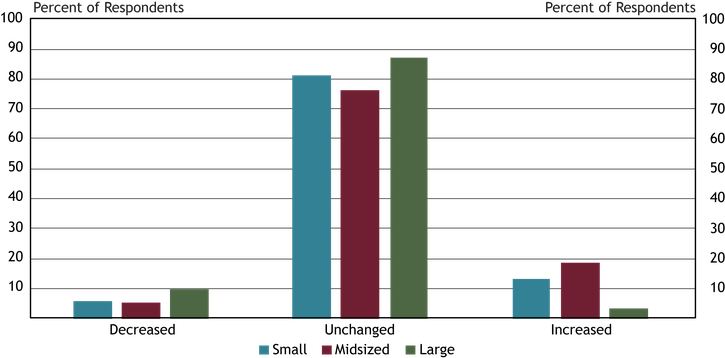
Source: FR 2028D, item 11.
Note: Small banks have total assets of $1 billion or less, midsized banks have total assets between $1 billion and $10 billion and large banks have total assets greater than $10 billion.
About 81 percent of respondents reported that credit line usage did not change during the second quarter. The percentage of midsized banks reporting an increase in credit line usage doubled from the previous quarter. Additionally, large banks which reported no increase in credit line usage in the first quarter, reported a 3 percent increase in the second quarter. Similar to the first quarter, the most commonly cited reasons for a change, whether an increase or decrease, were differences in local or national economic conditions and in borrowers’ business revenue or other business-specific conditions.
Chart 8: Loan Demand Remains Stable for Most Banks
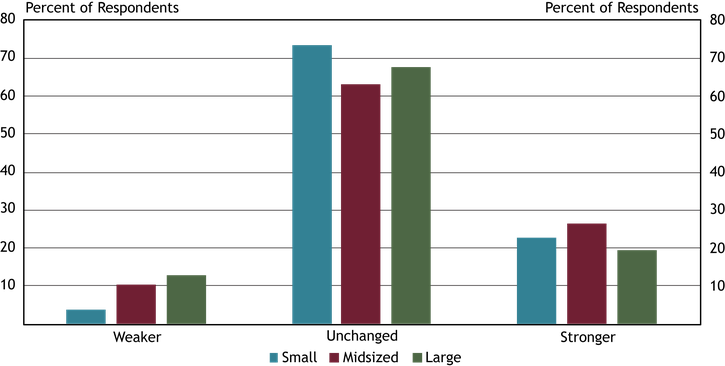
Source: FR 2028D, item 13.
Note: Small banks have total assets of $1 billion or less, midsized banks have total assets between $1 billion and $10 billion and large banks have total assets greater than $10 billion.
Overall, 69 percent of respondents indicated no change in demand for small business C&I loans in the second quarter, nearly unchanged from the first quarter. Among the 31 percent reporting a change, more respondents experienced stronger demand. Among these banks, 23 percent of small banks and 19 percent of large banks reported strengthening, a notable increase for both groups compared with the first quarter. The proportion of midsized banks that reported strengthening decreased 3 percentage points from the first quarter.
Chart 9: Application Approval Rates Increase for Small and Midsized Banks
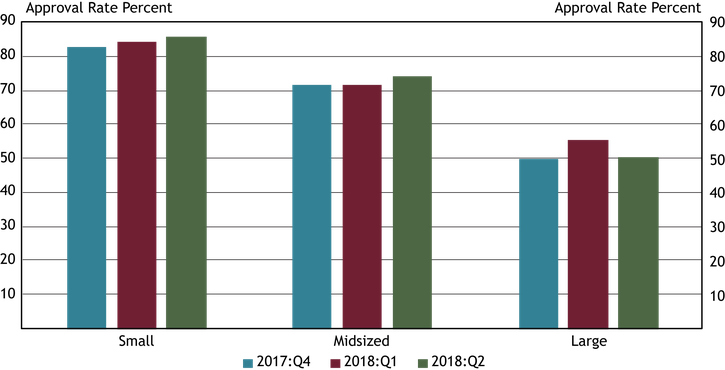
Source: FR 2028D, items 14.a and 17.
Note: Small banks have total assets of $1 billion or less, midsized banks have total assets between $1 billion and $10 billion and large banks have total assets greater than $10 billion.
Application approval rates in the second quarter increased slightly for small and midsized banks. Application approval rates varied from 83 percent at small institutions to 50 percent at large institutions. The most common reasons for denying a loan were borrower financials and borrower credit history.
Chart 10: Small Business Credit Quality Remains Stable
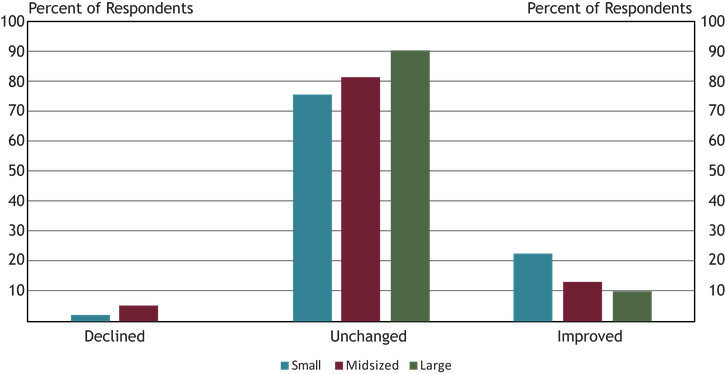
Source: FR 2028D, items 24 and 25.
Note: Small banks have total assets of $1 billion or less, midsized banks have assets between $1 billion and $10 billion and large banks have assets greater than $10 billion.
About 20 percent of respondents reported a change in credit quality over the quarter, with a majority of those banks reporting an improvement. About 40 percent of respondents cited the liquidity position of business owners as an important cause for this increase. Other important reasons contributing to improvements in credit quality were recent growth in business income, debt to income levels of business owners, prospects for business growth or enterprise values and quality of business collateral.
Chart 11: Banks Continue to Tighten Credit Terms
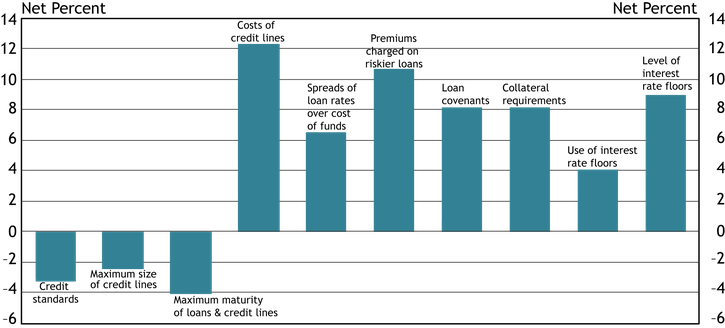
Source: FR 2028D, items 18 and 19.
Note: The net percent refers to the percent of banks that reported having tightened (“tightened considerably” or “tightened somewhat”) minus the percent of banks that reported having eased (“eased considerably” or “eased somewhat”).
About 50 percent of respondents indicated some change in credit standards or terms for small business C&I loans during the second quarter. Chart 11 shows diffusion indexes for credit standards (left-most bar) and various loan terms. The diffusion indexes show the difference between the percent of banks reporting a tightening and those reporting an easing. On net, 3 percent of banks reported loosening credit standards. Despite this, banks on net tightened all but two types of loan terms. Costs of credit lines, premiums charged on riskier loans and the level of interest rate floors experienced the most tightening.
Nearly 70 percent of the respondents who reported tightening indicated that a less favorable or more uncertain economic outlook and a reduced tolerance for risk were important factors in that decision. Other commonly cited reasons included worsening of industry-specific problems and increased concerns about the effects of legislative changes, supervisory actions, or changes in accounting standards. About 95 percent of respondents who indicated easing standards or terms reported that more aggressive competition from other banks was an important factor in that decision, and 67 percent of respondents cited more aggressive competition from nonbank lenders as important.
*Other contributors to this report include John Froud, Dan Harbour, Tom Hobson, Stefan Huggins, Alli Jakubek, Graham Redelsheimer, Tony Walker and Brad Wampler.
Contact Us
For questions or comments about this survey, contact us at KC SRM FR2028D Survey.
